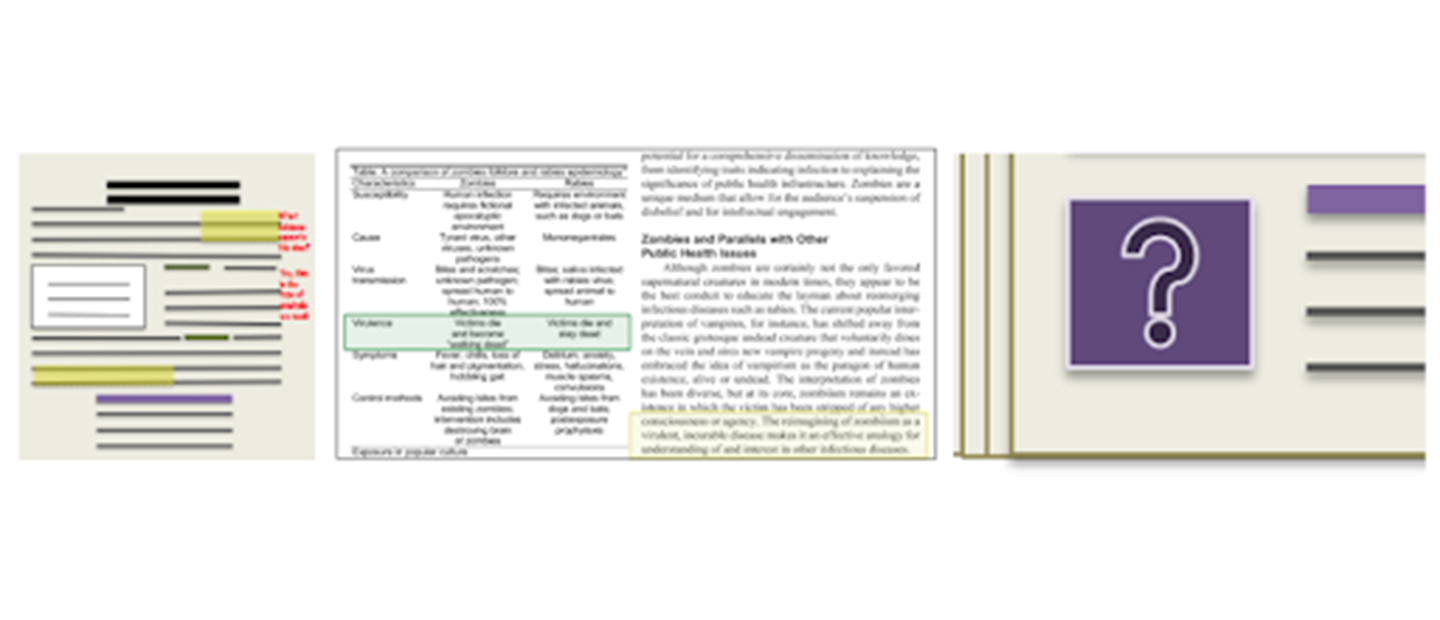Center for Excellence in Teaching and Learning
Kresge Library, Room 430
100 Library Drive
Rochester,
Michigan
48309-4479
(location map)
(248) 370-2751
[email protected]

Testing Students on How They Study
CETL Learning Tips are written for a student audience.
The highlighter may be the unofficial symbol of studying, but should it be? Highlighting and re-reading are generally poor ways for us to retain and apply what we learn (Dunlosky et al., 2013), but old habits are hard to shake. Early in the semester, prompt students to think about how they study and whether they should reconsider their approach. This teaching tip provides a low-prep way for students to compare their study habits to what research says are the best learning behaviors.
How Students Can Evaluate Their Studying
1. Have students identify their first reading assignment.
Have them identify what they need to read, by when, and for what purpose (for more on purpose, see Reading Outcomes Promotes Transparency Teaching Tip). This is a great way to engage students with the syllabus and have them start planning ahead. Make sure you have located this first reading assignment as well!
2. Ask students to write down how they would study the content they read.
When will they begin the read?
How often will they read and study the concepts?
What do they do?
What does studying look like to them?
Give them three minutes to respond in writing in phrases and lists as relevant, and encourage them to be as specific (and honest) as possible.
3. Have students match what they wrote to a list of study behaviors.
Display these 10 study behaviors, and ask students to label phrases with the corresponding behavior(s). After 1-2 minutes, ask them which behaviors they used the most and which they rarely, if ever, used.
- Distributed Practice: Implementing a schedule of practice that spreads out study activities over time
- Elaborative Interrogation: Explaining in your own words why a concept is true
- Highlighting/Underlining: Marking potentially important portions of materials during the initial reading
- Imagery used for text learning: Forming mental images of text materials while reading or listening.
- Interleaved Practice: Creating a schedule of study that combines interactive studying (via practice quizzes, self teaching, etc.) with review studying (flashcards, study guides) within a single study session
- Keyword Mnemonic: Using keywords and mental imagery to associate verbal materials
- Practice Testing: Taking practice tests to help learn the material
- Rereading: Reading the text material again after initial familiarization
- Self-Explanation: Describing how new information is related to known information, or explaining steps taken during problem solving
- Summarization: Writing summaries (of various lengths) of to-be-learned texts
4. Show students these study behaviors in order of effectiveness.
Explain that these study strategies have been studied in terms of how well students remembered what they learned based on the strategy they used (Dunlosky et al., 2013). Show students the results, as displayed below. Those who employed practice testing and distributed testing best retained and applied what they learned, while those who employed common strategies like rereading and highlighting gained the least from their study efforts.
The Most Effective
- G: Practice Testing ⇒ Taking practice tests to help learn the material
- A: Distributed Practice ⇒ Implementing a schedule of practice that spreads out study activities over time
Moderately Effective
- B: Elaborative Interrogation ⇒ Explaining in your own words why a concept is true
- I: Self-Explanation ⇒ Describing how new information is related to known information, or explaining steps taken during problem solving
- E: Interleaved Practice ⇒ Creating a schedule of study that combines interactive studying (via practice quizzes, self teaching, etc.) with review studying (flashcards, study guides) within a single study session
Least Effective
- H: Rereading ⇒ Reading the text material again after initial familiarization
- J: Summarization ⇒ Writing summaries (of various lengths) of to-be-learned texts
- C: Highlighting/underlining ⇒ Marking potentially important portions of materials during the initial reading
- F: Keyword Mnemonic ⇒ Using keywords and mental imagery to associate verbal materials
- D: Imagery used for text learning ⇒ Forming mental images of text materials while reading or listening.
5. Discuss this list, and how students might revise their study strategies.
Based on your discipline, in-class activities, and other considerations, encourage students to think critically about these study methods and their own study methods. Is a serial highlighter who consistently gets high marks proof that these findings are wrong? What does “practice testing” look like with your textbooks, readings, and other learning materials? Then, invite students to reflect on their initial response and consider what study strategies they might try out.
References and Resources
Dunlosky J., Rawson, K., Marsh, E., Nathan, M. J., & Willingham, D. (2013). Improving students’ learning with effective learning techniques: Promising directions from cognitive and educational psychology. Psychological Science in the Public Interest, 14(1), 4-58.
How Can We Convince Students That Easier Doesn’t Always Mean Better? This Chronicle of Higher Education article explains the concepts presented in this teaching tip and links to helpful student resources on learning, such as those from The Learning Scientists.
In OU professor Barbara Oakley’s renowned Learning How to Learn MOOC, she describes many practices that puts into effect these study strategies, such as interleaving, recall, and distributed practice.
Saundra McGuire’s Teach Students How to Learn (2015) provides a deep but accessible dive into how students can better grasp and apply what they learn. Available in the CETL Library.
Save and adapt a Google Doc version of this learning tip.
Written and designed by Christina Moore, Center for Excellence in Teaching and Learning at Oakland University. Others may share and adapt under Creative Commons License CC BY-NC.



